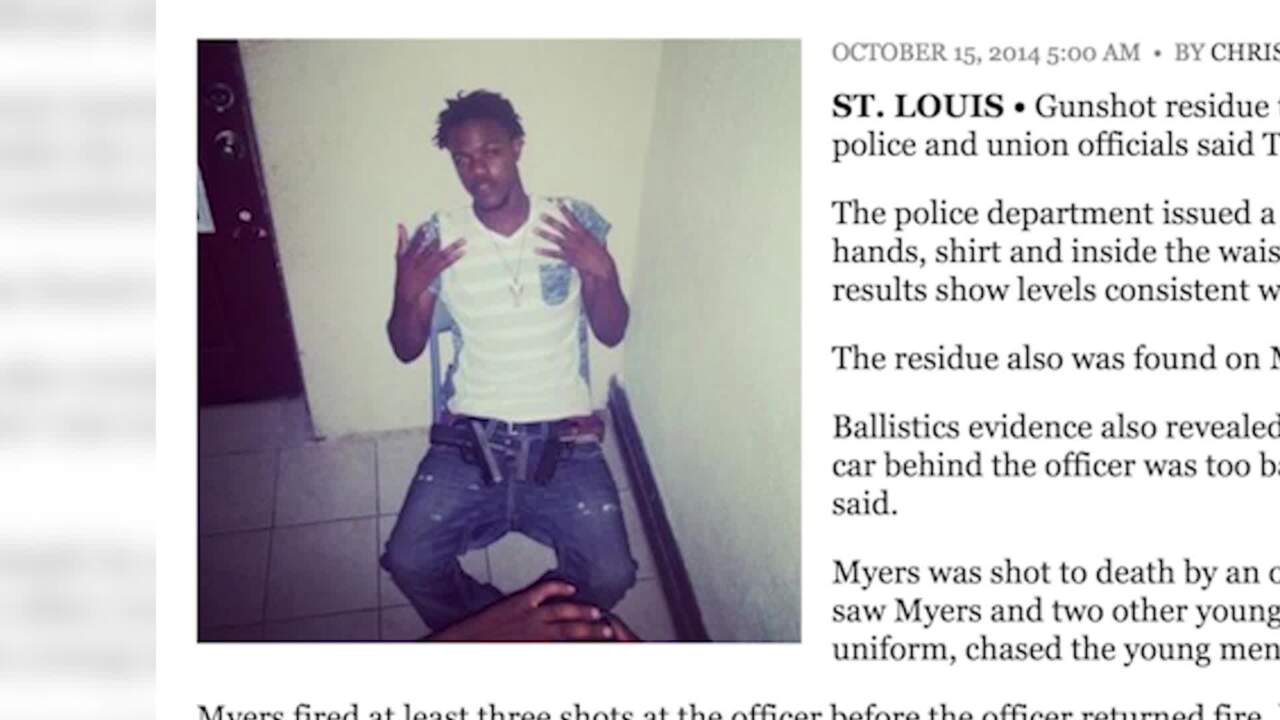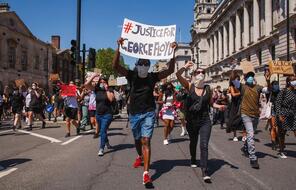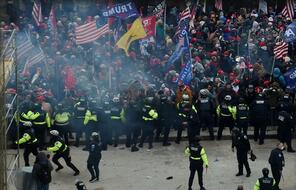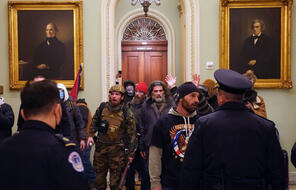Breadcrumb
#IfTheyGunnedMeDown
At a Glance
Language
English — USSubject
- Civics & Citizenship
- History
- Social Studies
- Racism
#IfTheyGunnedMeDown

BROOKE GLADSTONE: The beauty of social media is that it gives instant commentary and reaction to the press coverage.
There was, to me, just a stunningly brilliant hashtag campaign that followed the posting of menacing pictures of Michael Brown called #IfTheyGunnedMeDown. In other words, which picture of me would they use? Would they use the one of me in my marine uniform or the one of me in my hoodie? You know, would they use the picture of me in my business suit or in my disco dress? And so on and so forth.
LARRY MORRIS: This is an issue that African Americans have had with the media for a very long time. It is nothing new. Its not exclusive to St. Louis, Baltimore, Watts, any place theres been riots. When you see pictures of African Americans or black Americans, whatever you may choose, its always in a light thats negative. So #IfTheyGunnedMeDown was just to highlight [that].
Like me, I have my Bachelors degree and Im working on my Masters degree. Now, I dont really post a lot of pictures of me doing anything unsavory, but I have friends that will catch me in the moment. What are you going to put up of me? Because image is everything. A picture is a thousand words. If the first thing you see is me with a red cup in my hand and a bottle of vodka, youre going to automatically make the assumption, Well, he likes to party it up. Hes crazy. But you know, you wouldnt know that Ive been trained in certain things, that Im involved in my community, and thats what that whole movement was about.
How would they depict me? What would they pick and it was just very, very strong, it was a very strong sentiment that the way that they did it was wrong. But, like you said, some people would be like, They were showing him from what he really is. Well, nobodys perfect.
YAMICHE ALCINDOR: #IfTheyGunnedMeDown was a great hashtag, because I think it allowed people in the media to really understand what people were thinking when they see these photos and make kind of understand the complexity that goes into kind of choosing photos and choosing how you define someone and choosing how you really tell the world about someone.
As reporters, were up against deadlines, were up against word limits, were up against all this stuff thats kind of making me try to simplify a story. And I think the hashtag #IfTheyGunnedMeDown made me think, even as we simplify, even as we try to tell people stories in 500 words, try to get more of who that person was.
JEAN BUCHANAN: We had one of Michael Brown in his cap and gown that we used a few times. There is a certain segment of the population that was furious every time we used it, cause, you know, Michael Browns a thug and here we are showing him in a cap and gown.
You know, people are many things. Kids pose, they do stupid things. I think you have to be really careful when youre using photos of children and, you know, are you presenting this 13-year-old as a thug? I mean, hes a kid, so I just think you have to be really careful with what you do.
I think its really important that news organizations just be fair and try to be neutral when they choose photos of people, particularly victims in crimes. And perpetrators in crimes.
DAVID CARSON: We had a situation here in St. Louis where a gentleman hadVonDerrit Myershad a run-in with police and it ended up being a fatal shooting by the police officer who shot him.
The family contends VonDerrit did not have a gun. The police investigation showedand I think accurately showedthat VonDerrit did have a gun and was firing back at the police officer that was chasing him.
I think its credible in this case that VonDerrit had a gun and one of the reasons why I say its credible is that if you looked on social media, there were pictures of VonDerrit holding the stolen gun that was recovered at the scene days before thatthat were posted to social media days before thatand we ran with that picture.
We ran that picture in the paper because I think that picture with VonDerrit holding a gun, and it was the stolen gun that was recovered at the scene, was an important piece of the story that was going on here. It sort of backed up and provided validity to what the police saidthat they recovered this gun. It would be very hard to reproduce and fake ahead of time.
People got mad about us choosing the picture with VonDerrit with the gun, but it had been circulated on social media even before we chose it. Its not the only representation of him that we put out. We also have used a mug shot of him. But it is part of this story now. Now there are people saying youre slandering his name. I dont think were slandering his name. This really happened, this was a picture that he and his friends had posted on social media. This is how they were portraying themselves at that particular time.
KENYA VAUGHN: As an African American person, we have this certain way that we intentionally or organically idealize a person that theyve passed away. Its just kind of what we do as people. We want to showcase the best part of them.
But people always say, Well, if it bleeds it leads or the more sensational, the more hits. But we kind of incorporate a sense of social responsibility in our reporting and that goes into selecting photos as well. This is my personal policy: as a human being, what would I want the last photo of my child or my nephew or my niece or something to be? I have the fortunate liberty to be part of an aspirational, advocacy-type news organization where I have that liberty to do that. Not everyone does, but at the same time its like, as a human being what would I want somebody to have as a last picture of me?
BROOKE GLADSTONE: In the day, when a reporter was on the bummer beat, and they were going to get a picture of the victim, generally they let the family choose. That was almost always the case. You know if somebody was gunned down by, you know, some crazy gunman, or even was caught in a crossfire, or for whatever reason, out of respect for the family, they would let the family choose the picture.
DAVID CARSON: With social media, things are different because people are publishing photos of themselves online that are accessible and people can find and sometimes digital organizations are finding the photographs on their own without going through the family.
Theres always a debate there about what photo youre going to use to represent people and I think thats also important for people to remember that these things they post on social media can be seen by many people and images are a powerful thing and they can change how youre perceived.
I dont know what the answer to that is.
YAMICHE ALCINDOR: The solution, as you said, is youre kind of open to bias no matter what picture you choose. Likely youre probably going to have one picture in the paperI work for a newspaper. In broadcast or online you might have multiple pictures. So I think that for one, as news organizations, we should probably strive for multiple pictures of somebody instead of one picture. Weve seen multiple pictures of Trayvon Martin, weve seen multiple pictures of Michael Brown. Its best, I think, to use multiple pictures of someone.
But I think if you have one picture to deal with, I think, one, it should probably come from the family if its something thats relevant and something thats kind of recent. But I also think that it should also be relevant to what was going on at the time. So, if you were a veteran five years ago, but only last year this picture was taken of you kind of hanging out at the beach, I might use the five-year picture, but the most relevant picture and the most recent picture is you on the beach.
BROOKE GLADSTONE: Everything conveyed by a picture, and the picture selected via an unconscious bias, a bias that will confirm what it is you think you really understand about a situation that you really dont understand at all.
#IfTheyGunnedMeDown
You might also be interested in…
10 Questions for the Past: The 1963 Chicago Public Schools Boycott

#IfTheyGunnedMeDown

The Impact of Identity

The Power of Images

Preparing Students for Difficult Conversations

Social Media and Ferguson

Verifying Breaking News

Facing Ferguson: News Literacy in a Digital Age

Reflecting on George Floyd’s Death and Police Violence Towards Black Americans

Responding to the Insurrection at the US Capitol

The Hope and Fragility of Democracy in the United States
What Happened During the Insurrection at the US Capitol and Why?


